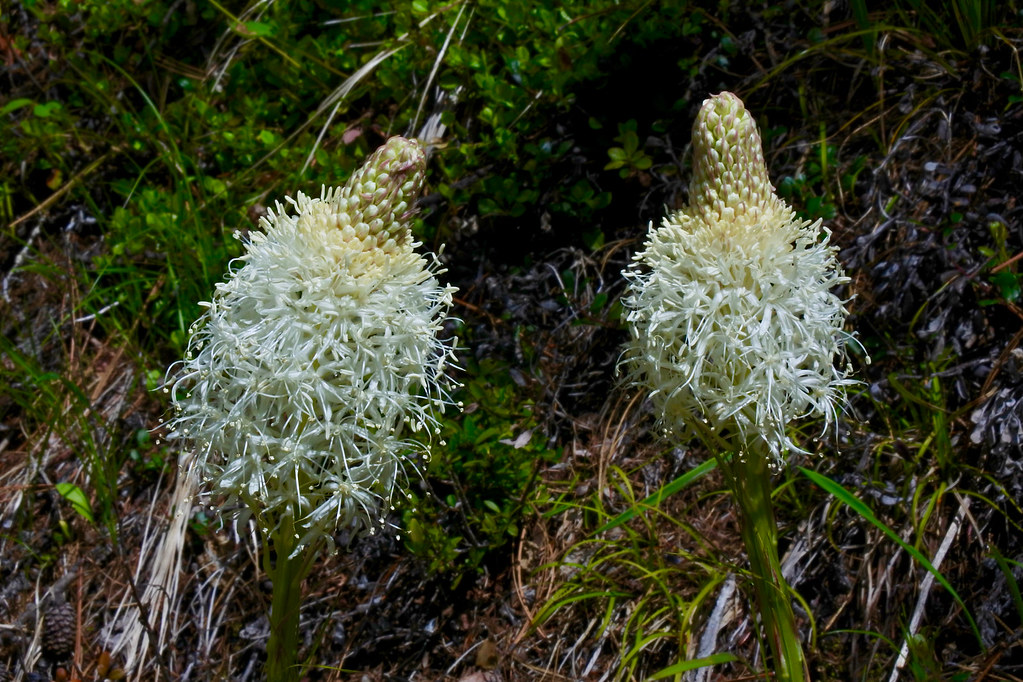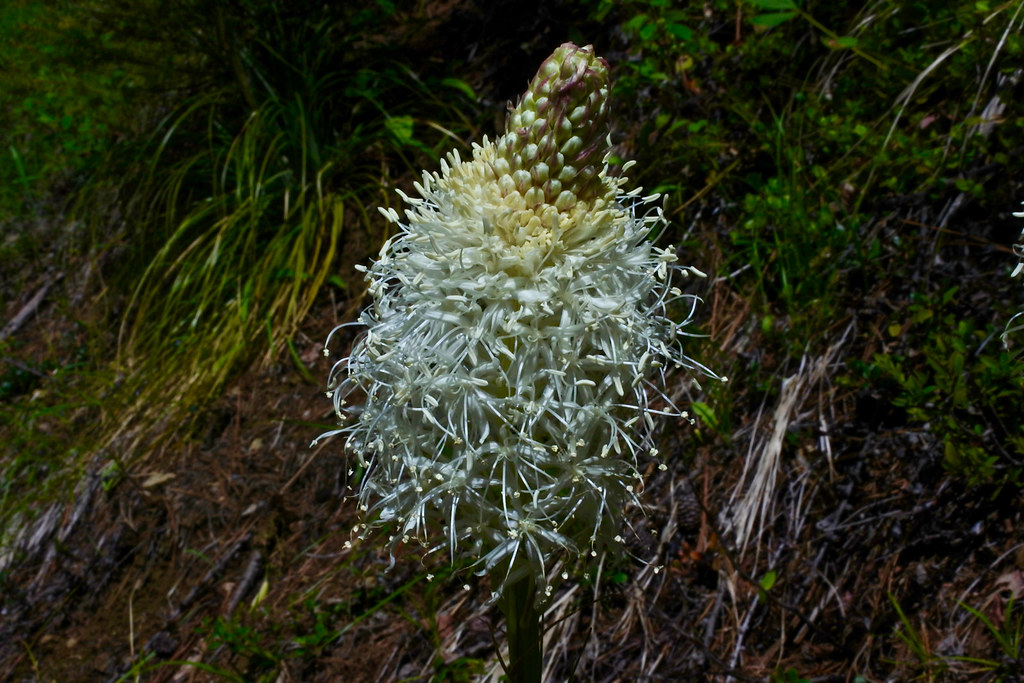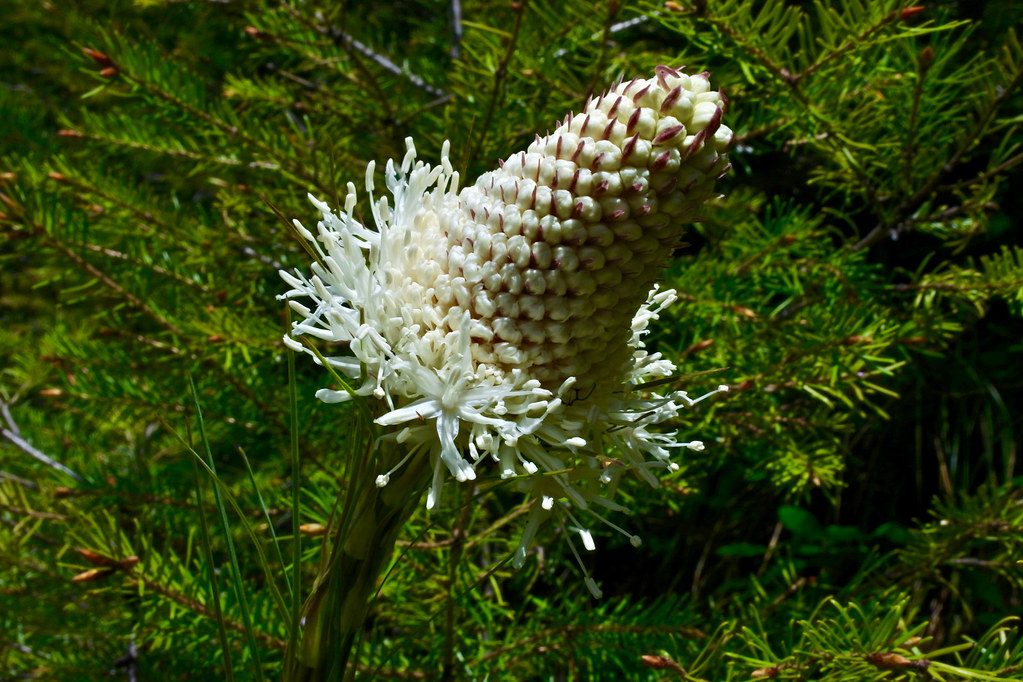May 26, 2016
Bear Grass ~ Xerophyllum tenax





Bear-Grass is the only evergreen member of the lily family. Its flowering stems grow from off-shoot plants growing at the base of each “grassy” clump and appear at each plant every five to ten years. The flowers are large (approximately 3” X 4”), blooming at the tops of stalks that are around four and a half feet tall. The genus name comes from the Greek word xeros meaning “dry,” and phyllon meaning “leaf” and the species name tenax means “holding fast”, referring to the tough pliable leaves which were used by the indigenous people to make ornamental baskets. The plant is poisonous although some think that bears eat the fleshy leaf bases in the spring. I’ve never seen bears eat it, but I have seen grassy bases that have been severely disturbed in the spring. The plant is native to six of the far western states in the U.S. and the two western provinces of Canada and in this area usually likes elevations over about 5,000 feet.
You can find a wealth of information on them here .
RSS feed for comments on this post. TrackBack URI
Reading some of the rangers’ comments from Glacier Park, just where and how profusely this will appear each year can be a mystery. Seems like it must grow in cycles, meaning that wherever people find a lot of it one summer may have very little the next. Is this similar to where and when you find it?
LikeLiked by 1 person
Comment by Malcolm R. Campbell — May 26, 2016 @ 9:28 am
I’ve seen that too but I have no idea what causes it. I would guess the weather conditions, especially during the previous winter, have a lot to do with it.
LikeLike
Comment by montucky — May 26, 2016 @ 9:33 am
After I got interested in native plants in 1999, one of the lessons I learned by 2000 is that a place that haa lots of wildflowers of a certain species one year might have few or even none on the same date the following year.
LikeLiked by 1 person
Comment by Steve Schwartzman — May 28, 2016 @ 6:45 am
Many of them have cycles that we don’t understand. Many berry producing plants are like that too.
LikeLike
Comment by montucky — May 28, 2016 @ 7:28 am
Beautiful! Thanks for sharing as it’s not something we get to enjoy in Ohio.
LikeLiked by 1 person
Comment by centralohionature — May 26, 2016 @ 11:19 am
This one really beautifies the mountainsides up high this time of year. I hope I will be able to find them in the abundance that the sometimes have. It’s an amazing sight.
LikeLike
Comment by montucky — May 27, 2016 @ 7:16 am
I imagine a bear just waking up in spring would be hungry enough to eat just about anything. I’m glad that they didn’t get these examples though, because they’re beautiful and unusual.
LikeLiked by 1 person
Comment by New Hampshire Garden Solutions — May 26, 2016 @ 3:02 pm
Bears do have to exist and even gain weight on nothing but leaves, grass and roots for most of the summer and then put on extra weight for winter when the berries ripen, so they know every edible plant in their territory. Personally I doubt that they do eat this one because it’s leaves are tought enough to use for basket making.
LikeLiked by 1 person
Comment by montucky — May 27, 2016 @ 7:19 am
I’ve only ever seen this in the States, not in Canada (not saying it doesn’t grow here). It’s quite a unique shape.
LikeLiked by 1 person
Comment by wordsfromanneli — May 26, 2016 @ 3:07 pm
I remember seeing these when I was kid along the roads at pass level. These were at an altitude of about 5000 feet.
LikeLiked by 1 person
Comment by montucky — May 27, 2016 @ 7:20 am
That might explain why I don’t see them much!
LikeLiked by 1 person
Comment by wordsfromanneli — May 27, 2016 @ 9:46 am
What a lovely flower. They’re so unusual and remind me a little of our swamp lily.
LikeLiked by 1 person
Comment by Vicki — May 26, 2016 @ 6:07 pm
They are unusual wildflowers because of their very large size, but some years they simply command the higher elevation mountainsides; quite a sight!
LikeLiked by 1 person
Comment by montucky — May 27, 2016 @ 7:22 am
Fantastic photos … I don´t think we have this flower in the part of Sweden were I live … // Maria 🙂
LikeLiked by 1 person
Comment by mariayarri — May 27, 2016 @ 2:22 am
To the best of my knowledge their range is only is the far western parts of the US and Canada. I wish you could see them though!
LikeLike
Comment by montucky — May 27, 2016 @ 7:23 am
I remembered the name, but i’d forgotten how lovely and unique the plant is. I read that their bloom cycle is quite irregular, and can be anywhere from five to ten years. If that’s so, it’s nice that there are so many of them, so you can enjoy them every year. They’re bigger than I realized, too. A whole mountainside covered with them has to be a remarkable sight.
LikeLike
Comment by shoreacres — May 27, 2016 @ 6:59 pm
In the nest few days I’m going to see if I can find an area where thery cover the landscape: if I can’t find one I’ll post some photos from precious years. They are a spectacular sight.
LikeLike
Comment by montucky — May 27, 2016 @ 7:05 pm
Some of these look to my imagination like fireworks going off.
LikeLiked by 1 person
Comment by Steve Schwartzman — May 28, 2016 @ 6:47 am
The very tall stalks on which the flowers grow adds to that appearance. I’ve seen many over 5 feet tall. Some large clumps remind me of the climax of a fireworks display where the sky is full of bursts.
LikeLike
Comment by montucky — May 28, 2016 @ 7:31 am
Hi Montucky, I don’t think I have ever seen any of this plant although perhaps I had and not known of it. Beautiful plant with those fluffy blooms. Have a wonderful coming week!
LikeLiked by 1 person
Comment by wildlifewatcher — May 30, 2016 @ 7:03 pm
I hope you have a great week too! Stay safe!
LikeLike
Comment by montucky — May 30, 2016 @ 9:30 pm
I love seeing your photos of this every year! So unique.
LikeLiked by 1 person
Comment by Candace — May 31, 2016 @ 12:00 pm
I’m glad that you like them too. I look forward to them every year!
LikeLike
Comment by montucky — May 31, 2016 @ 4:30 pm
Interesting looking and checked not in Finland. Nice photos.
LikeLiked by 1 person
Comment by Sartenada — June 7, 2016 @ 2:37 am
They are some of our largest wildflowers, but they like higher elevations, usually over 5,000 feet.
LikeLike
Comment by montucky — June 7, 2016 @ 8:23 am